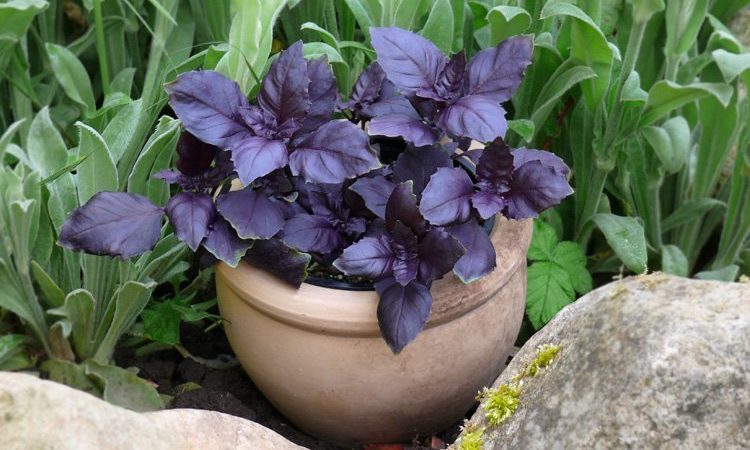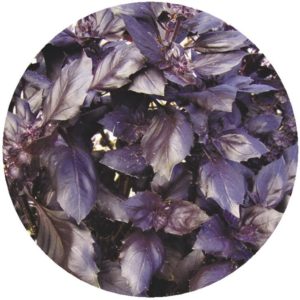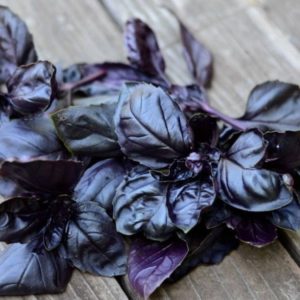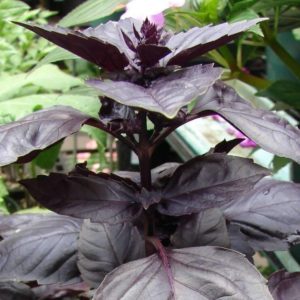Review of "Ararat" purple basil vegetable variety
Purple basil varieties are distinguished by their strong aroma and rich taste. Ararat stands out among them. He is preferred by many gardeners. Let's consider the properties of the vegetable basil Ararat, its advantages, differences from other varieties and the technology of growing from seeds.
The content of the article
Features of the variety
Ararat was established in central Russia in Agrofirma Poisk LLC, Moscow region, in 2004 it was entered in the State Register. It is recommended to grow it in all regions of the country.
Ararat purple basil has a rich, tart taste and a rich, complex aroma.
It became widespread due to its advantages:
- easy to grow;
- unpretentious in care;
- versatile in application;
- has a sharp, rich taste due to the high content of essential oils, its own unique aroma with notes of cloves, allspice and anise;
- used in landscape design due to the high decorative properties of the bush;
- good for drying (rich aroma remains);
- has a high yield.
In the photo - Ararat basil.

Feature and Description
Basil Ararat forms an erect, semi-spreading bush up to 60 cm high. Leaves are ovoid with denticles at the edges, green-purple, medium-sized, lilac flowers.
The plant blooms 71 days after germination. At the beginning of flowering, the basil is ready to be cut. By this time he is accumulating a sufficient amount of nutrients and essential oils. The variety is considered mid-season.
The yield from 1 m² is 2-2.2 kg of greenery.
Chemical composition
The plant is rich in vitamins, minerals and complex organic compounds.
100 g of leaves contain:
- vitamin A - 264 mcg;

- C - 18 mg;
- B - 0.542 mg
- K - 414.8 mcg;
- PP - 0.902 mg;
- E - 0.8 mg;
- carotene - 3.142 mg;
- mono- and polysaccharides - 0.3 g;
- saturated fatty acids - 0.04 g;
- choline - 11.4 mg;
- iron - 3.17 mg;
- copper - 0.04 mg;
- zinc - 0.81 mg;
- manganese - 1.148 mg;
- magnesium - 64 mg;
- calcium - 177 mg;
- potassium - 295 mg;
- selenium - 0.3 mcg;
- sodium - 4 mg;
- phosphorus - 56 mg;
- vegetable fiber - 1.65 g
Basil contains essential oils:
- camphor;
- saponin;
- ocimen;
- methylchavicol.
The combination of these oils defines the aroma of the plant.
The calorie content of Ararat basil is 25 kcal per 100 g of product.
Plant resistance
Despite its thermophilic character, Ararat basil is more resistant to adverse conditions in comparison with other varieties.
Basil loves to be illuminated by the sun all day, does not tolerate stagnant water. The soil under the bushes should always be slightly damp.
It is a heat-loving plant. The optimum temperature for growth and development is + 18… + 27 ° C. At lower rates, basil stops growing. The culture does not tolerate frost and immediately dies.
Basil of the Ararat variety is resistant to disease, however, under adverse weather conditions it can undergo fungal infections: gray rot, black leg and fusarium.
Scope of the Ararat variety
Purple leaves of the plant contain an increased amount of essential oils compared to green ones. Thanks to this, it has a rich taste and aroma of allspice, cloves and anise.
The Ararat variety is used:
- when preparing dishes from meat, fish, legumes, tomatoes;
- when canning vegetables;
- when cooking jams, soups, sauces;
- as an additive to tea, compote.
Basil greens are dried, frozen, salted for future use for the winter.
Due to its rich chemical composition, basil has long been used not only for culinary but also for medicinal purposes. It is used:
- in aromatherapy as an aphrodisiac (calms the nervous system, relieves headaches);
- in the treatment of wounds;
- in cosmetology (improves the condition of the skin and nails).
Purple basil protects against radiation. Oil prepared on the basis of Ararat is an excellent relaxant if you add it to bathing water.
Attention! Before using basil for medicinal purposes, consult your doctor.
Growing technology
Basil is grown in a greenhouse, on a windowsill, in the open field.
Important to remember! Basil should not be planted in one place for more than 3 years, otherwise there is a risk of Fusarium infection of all nearby plants.
Tomatoes, bell peppers, potatoes, and legumes are considered good neighbors for basil.
Optimal conditions
Basil is planted in a sunny place, protected from drafts. For the leaves of Ararat to be bright purple, the plant needs a lot of sun.
Air temperature for normal growth is above + 18 ° C.
Basil loves moist, humus-rich soils without stagnant water.
Sowing terms and rules
Seedling boxes should be in a warm, sunny place. Seeds for seedlings are sown 2 months before transfer to open ground. Place 3-4 seeds in each well.
Seedlings at the age of 25 days, they are transplanted into open ground. This is done after the end of spring frosts, in the evening, in calm weather. Land in front landing treated with a solution of potassium permanganate to protect against fungal infections.
Prepare holes 10 cm deep at a distance of 20 cm from each other, watered abundantly with warm water, place seedlings there together with an earthen clod, sprinkle with earth, lightly tamping, and watered again. Complex nitrogen fertilizers are added 2 weeks after planting.
Reference. Top dressing is one of the important conditions for obtaining a rich harvest.
Further care
Basil care should be regular to ensure optimal conditions for growth and development. Timely feeding, watering, loosening is the key to a good harvest of spicy greens.
Purple Ararat requires regular watering. To avoid stagnant water, the soil must be well drained. Waterlogging is fraught with fungal infections, and the lack of moisture makes the leaves small and affects the taste.
Water the plant under the root in the morning with warm, settled water. The soil should always be slightly damp.
They loosen the ground under the basil bushes and remove the weeds once a week after watering.
The first feeding is needed 2 weeks after planting. Then this is done once a month before flowering. Nitrogen fertilizers are used.
To make the bush voluminous, with many side shoots, pinch the basil. The first time is at the stage of 6-8 leaves.
Under unfavorable conditions, Ararat Basil affects:
- Gray rot. It develops with high humidity, so plants in greenhouses and hotbeds are more often infected. Gray spots and mildew appear on the leaves. The plant dies.
- Blackleg. The fungus affects the basal neck and stem. Excessive watering and acidic soil lead to the disease.
- Fusarium. The fungus infects the entire plant, which dries up from the top. The infection is in the soil, so you can't plant basil in one place.
Fungicides are used to treat fungi.
Attention! Treatment with fungicides and herbicides is carried out no later than 20 days before harvest.
Of the pests, aphids and garden mites may attack. In this case, folk remedies are used (a solution of onion peels with laundry soap) or drugs from a store.
Features of growing by seeds / seedlings
Difference in the method of growing by seed or seedlings, in a greenhouse or open field is that the harvest of greens is obtained at different times.
In the open field
In central Russia, due to the unpredictability and instability of temperature conditions, purple basil Ararat in the open field is better grown using seedlings, then the harvest will be earlier.
Seeds are sown in the ground after the end of spring frosts, when the soil warms up, in early June. In this regard, the harvest will ripen much later.
In the southern regions, basil is sown in the ground and seeds are sown in the beds during the summer. This is how another generation of plants grows.
In the greenhouse
Basil is grown in the greenhouse all year round at a temperature of + 20 ... + 25 ° C.An important condition is antifungal treatment of the earth with a solution of potassium permanganate or fungicides.
The seeds are prepared by preheating them in a bag on a radiator for a week, then soaked in a solution of potassium permanganate for 2 hours.
Seeds are sown in pots with prepared soil to a depth of 0.5-1 cm; there should be a drainage layer at the bottom of the pot. In order for the seeds to sprout better, they are covered with a film, creating a microclimate. At the stage of 2 true leaves, seedlings are dived, left in pots or planted in the soil of the greenhouse.
At home

A drainage layer and organic-rich soil are poured into the pot and watered well. The seeds are placed to a depth of 0.5-1 cm and covered with foil. They dive when 2 true leaves appear.
If the pot is large in size, several seedlings are placed in it. Placed in a sunny place without drafts, watered regularly. If the air in the house is dry, a bowl of water is placed next to the plant. The plant is fed, loosened and pinched.
At home, you can grow basil, dug in August from the garden. He will delight all winter.
Reviews of summer residents about the purple variety of Ararat basil

Reviews of the Ararat variety are always positive. Summer residents note the ease of cultivation and high yields.
Svetlana Izhevsk: “Not a single year can I do without the Ararat Basilica. I sow it in a greenhouse, then transfer it to open ground. Transplant perfectly. Always dry for the winter. Meat without it is not meat. "
Tatiana, Moscow: “When dried, the aroma does not change like other varieties. The germination rate is excellent. It grows well in greenhouses and outdoors. "
Natalia, Pskov: “I always buy Ararat purple. Feels great in the garden and on the windowsill. I add basil to strawberry jam, to tea, I cook many dishes with it. Wonder how good! "
Conclusion
Variety of purple basil Ararat is distinguished by high seed germination, productivity, resistance to diseases with proper care. Due to the high content of vitamins, trace elements and essential oils it is widely used in cooking and cosmetology.
If you provide the plant with the optimal temperature and light conditions, and prevent water stagnation, you can grow a fragrant spice not only in the garden or greenhouse, but also on the windowsill.